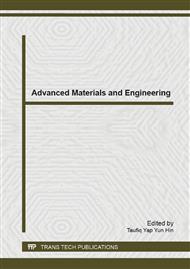[1]
J. Sandler, M.S.P. Shaffer, T. Prasse, W. Bauhofer, K. Schutle, A.H. Windle, Development of a dispersion process for carbon nanotubes in an epoxy matrix and the resulting electrical properties, Polymer 40 (1999) 5967-5971.
DOI: 10.1016/s0032-3861(99)00166-4
Google Scholar
[2]
O. Jacobs, H.Y. Chen, W. WuG. RüdigerB. Schäel, Effect of dispersion method on tribological properties of carbon nanotube reinforced epoxy resin composites, Polym. Test 26 (2007) 351–360.
DOI: 10.1016/j.polymertesting.2006.11.004
Google Scholar
[3]
Kuang-Ting Hsiao, Justin Alms and Suresh G Advani, Use of epoxy/multiwalled carbon nanotubes as adhesives to join graphite fibre reinforced polymer composites, Nanotechnology 14 (2003) 791–793.
DOI: 10.1088/0957-4484/14/7/316
Google Scholar
[4]
M. K. Abdullah, M. Z. Abdullah, M. A. Mujeebu, S. Kamaruddin, Z. M. Ariff, A study on the effect of epoxy moulding compound (EMC) rheology during encapsulation of stacked-chip scale packages (S-CSP), J. Reinf. Plast. Compos. 28 (2009) 2527–2538.
DOI: 10.1177/0731684408092409
Google Scholar
[5]
Lei Yan, Huaiyuan Wang, Chao Wang, Liyuan Sun, Dujuan Liu, Yanji Zhu, Friction and wear properties of aligned carbon nanotubes reinforced epoxy composites under water lubricated condition, Wear 308 (2013) 105-112.
DOI: 10.1016/j.wear.2013.10.007
Google Scholar
[6]
Prashant V. Kamat, Nada M. Dimitrijević, Colloidal semiconductors as photocatalysts for solar energy conversion, Solar Energy 44 (1990) 83-98.
DOI: 10.1016/0038-092x(90)90070-s
Google Scholar
[7]
Philip Ball, Laura Garwin, Science at the atomic scale, Nature 355 (1992) 761-766.
Google Scholar
[8]
R. E. Cavicchi and R. H. Silsbee, Coulomb suppression of tunneling rate from small metal particles, Phys. Rev. Lett. 52 (1984) 1453.
DOI: 10.1103/physrevlett.52.1453
Google Scholar
[9]
Jimei Mou, Lide Zhang, The development tendency of nanocomposites, Phys 25 (1996) 31-36.
Google Scholar
[10]
Jiahua Zhu, Suying Wei, Dan Rutman, Neel Haldolaarachchige, David P. Young, Zhanhu Guo, Magnetic polyacrylonitrile-Fe@FeO nanocomposite fibers-electrospinning, stabilization and carbonization, Polymer 52 (2011) 2947–2955.
DOI: 10.1016/j.polymer.2011.04.034
Google Scholar
[11]
Di Zhang, Ruby Chung, Amar B. Karki, Feng Li, David P. Young and Zhanhu Guo, Magnetic and magnetoresistance behaviors of solvent extracted particulate iron/polyacrylonitrile nanocomposites, J. Phys. Chem. C 114 (2009) 212–219.
DOI: 10.1021/jp908844r
Google Scholar


